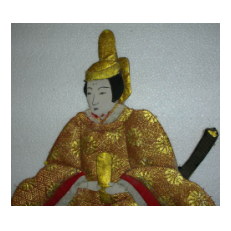
OSHIE DOLL
Meiji (circa 1880), cm 21x19.
The doll making has been elevated to art form in Japan, and Oshie dolls were extremely popular items among wealthy classes along the whole 19th century. They dolls were obtained recycling old, dismissed kimono silks, that were cut and fitted to padded cardboard outlines usually representing either a Geisha or a Samurai.
The whole had been then mounted on heavier cardboard and a stick, as customary. Condition is great with just a tiny bit of wear on silks due to age. A rare, interesting and funky thing.
__________________________________________________________________________________________________________________________
*OSHIE ZAIKU
Japan, Meiji (c. 1900), 37x6cm
A sombre life style and frugal habits were a standard for Japanese people, at least until WWII. This relates with poverty at the countryside of course, was linked to a certain ethics of upper classes anyway.
To this, it must be noted that in Edo Japan the government was based upon a division of classes that, in descending order, were: samurai, farmer, artisan and lastly merchant. The reasoning was that the Shogun needed protection, so most important were his soldiers, the samurai.












